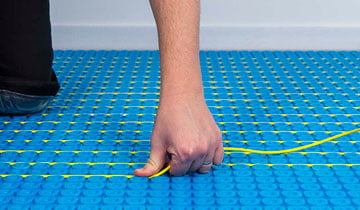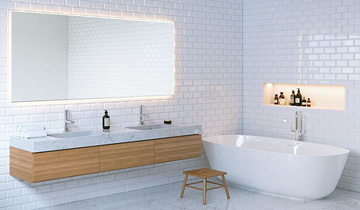7 min read
How thick is underfloor heating?
When looking into installing underfloor heating, ‘how thick is underfloor heating?’ ranks in the top three of the most common questions asked. There...

You may have experienced the sheer joy and comfort of underfloor heating at a friend’s or neighbour’s house. You may have also been told about the life enhancing benefits of it when choosing your new bathroom suite at your local bathroom showroom. But have you asked yourself the question ‘is electric underfloor heating worth it?’.
In this blog, I’ll do my best to help you answer that question and as someone who has electric underfloor heating in my current property and had it in the previous property, I’ll also give an honest view on what it is like living with electric underfloor heating.
I must mention, that I never once installed electric underfloor heating as a renovation project, it had already been installed which was part of the appeal of the property.
So, is electric underfloor heating worth it? No…
What? But you work for an electric heating manufacturer.
Correct! But hear me out.
Remember that I mentioned I had electric underfloor heating in my current and previous property? Well, we had problems with both.
Why? The quality of the installation of the electric underfloor heating system was not good. In fact, it was terrible.
A modest two-bedroom end of terrace that had electric underfloor heating under a tiled floor that led from the kitchen to the conservatory. The thermostat was on the wall in the conservatory and one day, whilst turning the underfloor heating on for the first time since we moved in, it tripped the fuse board.
Now, not yet an expert in electric underfloor heating, feelings of dread soon descended upon me. Thoughts of ripping up the beautifully tiled floor kept flowing through my mind. Especially how much it will cost to fix!
However, I was pointed in the direction of UFH Services who are specialist in electric underfloor heating repairs and they were local. Result!
Upon completing their investigation and using a thermal imaging camera, they discovered several problems.
An amazing thing that UFH Services did was to pinpoint exactly where the fault was in the heating cable so only one floor tile had to be lifted up to repair the system.
From what I recall, the cost of repair was about £350 which was much cheaper than I expected and the fear of ripping up the tiled floor was gone for good.
We’ve written a comprehensive article on repairing underfloor heating. So, if you want more detail on this read ‘Can you repair electric underfloor heating?’
A fairly modern four-bedroom detached house that has a tiled floor throughout the hallway, utility room, kitchen and dining room all of which has electric underfloor heating underneath.
With the electric underfloor working, I got a smart metre to help keep the ever-rising energy bills to a manageable level. Biggest mistake ever! Why? During the colder months we had the underfloor heating on and controlled by a programmable thermostat. However, my obsession with glancing at the smart metre every time I walked past alerted me to the cost going up quicker than a rat up a drain pipe! In fact, one day we hit £7.11 worth of electric and it was only 5.45pm!
To add insult to injury, a week later a leak was discovered in the central heating system. As part of the ‘crime scene investigation’, the chaps who came around to identify and fix the central heating issue used a thermal camera to track down the cause.
Good news, they found it! They also discovered that all of the electric underfloor heating had been installed without any insulation so it would naturally be costing so much more to use. Such a shame.
Nothing could be done to improve the efficiency of the system to the level I needed. Unless the tiles were ripped up and a new electric underfloor heating system was installed properly. Using insulation board would add 10mm to the floor height which sadly wasn’t considered as part of the renovation by the previous owners.
There’s a couple of insightful articles you can check out on improving the efficiency of underfloor heating. The first is ‘How do you make underfloor heating more efficient?’ and the second focuses on the importance of insulation, it’s called ‘Why removing insulation board from underfloor heating is costing homeowners.’
Electric underfloor heating is actually worth it. But to enjoy it, ensure that you have all the facts and have it installed by a recognised installer who has the experience of doing it and doing it well.
Here’s a list of key questions to consider when thinking about installing electric underfloor heating in your home:
Electric underfloor heating is a great addition to any home but to enjoy it make sure your installation is top notch and the five questions above have been considered. That way, you’ll avoid the experience I had.
A final note. I deliberately didn’t mention what brand of electric underfloor heating was installed in both properties because the product wasn’t the problem, it was how it was installed.

7 min read
When looking into installing underfloor heating, ‘how thick is underfloor heating?’ ranks in the top three of the most common questions asked. There...

8 min read
If you are in the market for an electric underfloor heating system for your next home renovation, then you have landed in the perfect place. We’ve...

5 min read
This is one of the most commonly asked questions and for good reason! With so many brands of underfloor heating out there including Warm Up, Heat Mat...